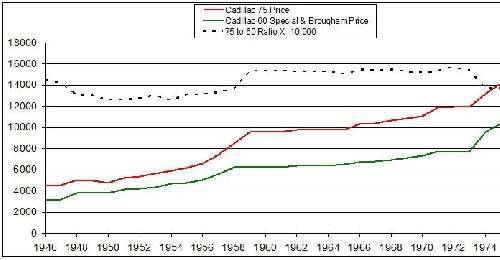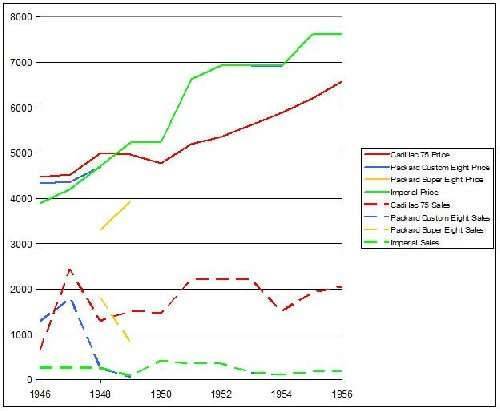Re: Postwar LWB Market Production
Posted by Mahoning63 On 2016/2/27 14:27:07
I threw some sales and pricing numbers in an excel file to see how it all looked in graphical form. Steve - I'll send you the file.
First chart shows Cadillac 75 vs. 60 Special and later Brougham. Dotted line is price ratio of 75 to 60 multiplied by 10,000 to get it to show up on the graph. It clearly shows that once the LWB competition vanished after 1954 for Packard and 1956 (effectively) for Imperial, Cadillac quickly increased its LWB price. For example, in 1954 the 75 was 25% higher than 60 Special but by 1959 it was 53% higher. Shrewd business folks, those Cadillac leaders! Volumes didn't suffer much in the Sixties and Seventies, the market seemed to simply absorb the increase.
Second chart shows sales and pricing for the three LWB luxury models through 1956. I also included the 1948-9 Super Eight. As Steve explained, Packard sales and pricing were both competitive with Cadillac in 1946-47. In 1948 the addition of the lower priced Super Eight cannibalized the Custom's sales. In 1949 when the Super Eight's price increased, sales dropped. One could look at all the data several ways but one way is to observe that both marques sold around 5900 LWB cars between 1946-49 and with similar pricing, but for Packard, 2600 of them were the much lower priced Super Eights and the marque had to absorb the expense of a major restyle while Cadillac 75 held pat.
In the 1950s, Imperial and Packard pricing was far enough above Cadillac to torpedo them despite any special attributes they may have had (and the 1955-56 Imperial had several). Am not sure why Imperial pricing was so high but for Packard, it is clear that Henney was the wrong outfit to make the car. I doubt any outside outfit could have done much better price-wise. Packard needed to follow Cadillac and do the work in-house. To do so, it needed enhanced body operations in Conner.
It's always easy to look back and point fingers but I do wonder why Nance didn't make the purchase of Conner a top priority long before Chrysler bought them. I get the money thing, but Packard's stock-in-trade had always been a robust catalogue of body styles, the result of a flexible and impressively creative in-house body shop. Had Nance set up within Conner efficient off-line operations to cut and weld inserts for doors, roofs and floorpans, the number of body styles could have proliferated to Packard's great advantage. For example, the simple addition of 5 inches to the '53 Clipper sedan's front and rear doors could have produced a 132 inch wheelbase car of similar length to the 60 Special that, while not having the aircraft carrier rear deck of the 60, wculd have had old school rear legroom that Packard's older customers would have loved. And the car could have easily accommodated an optional division window, allowing Packard to put out an entry limo priced much lower than the 75. There was even more that Packard could have done in 1953-54 with such body capability, such as lowering the hood and beltline of the hardtop and including a longer 4-door version, to create a sport series to take on Coupe DeVille, Eldorado and eventual Sedan DeVille. Probably the hood and fenders would have needed tooled new but you get the idea. Ah well...
Attach file:
 (29.73 KB)
(29.73 KB)

 (28.47 KB)
(28.47 KB)

First chart shows Cadillac 75 vs. 60 Special and later Brougham. Dotted line is price ratio of 75 to 60 multiplied by 10,000 to get it to show up on the graph. It clearly shows that once the LWB competition vanished after 1954 for Packard and 1956 (effectively) for Imperial, Cadillac quickly increased its LWB price. For example, in 1954 the 75 was 25% higher than 60 Special but by 1959 it was 53% higher. Shrewd business folks, those Cadillac leaders! Volumes didn't suffer much in the Sixties and Seventies, the market seemed to simply absorb the increase.
Second chart shows sales and pricing for the three LWB luxury models through 1956. I also included the 1948-9 Super Eight. As Steve explained, Packard sales and pricing were both competitive with Cadillac in 1946-47. In 1948 the addition of the lower priced Super Eight cannibalized the Custom's sales. In 1949 when the Super Eight's price increased, sales dropped. One could look at all the data several ways but one way is to observe that both marques sold around 5900 LWB cars between 1946-49 and with similar pricing, but for Packard, 2600 of them were the much lower priced Super Eights and the marque had to absorb the expense of a major restyle while Cadillac 75 held pat.
In the 1950s, Imperial and Packard pricing was far enough above Cadillac to torpedo them despite any special attributes they may have had (and the 1955-56 Imperial had several). Am not sure why Imperial pricing was so high but for Packard, it is clear that Henney was the wrong outfit to make the car. I doubt any outside outfit could have done much better price-wise. Packard needed to follow Cadillac and do the work in-house. To do so, it needed enhanced body operations in Conner.
It's always easy to look back and point fingers but I do wonder why Nance didn't make the purchase of Conner a top priority long before Chrysler bought them. I get the money thing, but Packard's stock-in-trade had always been a robust catalogue of body styles, the result of a flexible and impressively creative in-house body shop. Had Nance set up within Conner efficient off-line operations to cut and weld inserts for doors, roofs and floorpans, the number of body styles could have proliferated to Packard's great advantage. For example, the simple addition of 5 inches to the '53 Clipper sedan's front and rear doors could have produced a 132 inch wheelbase car of similar length to the 60 Special that, while not having the aircraft carrier rear deck of the 60, wculd have had old school rear legroom that Packard's older customers would have loved. And the car could have easily accommodated an optional division window, allowing Packard to put out an entry limo priced much lower than the 75. There was even more that Packard could have done in 1953-54 with such body capability, such as lowering the hood and beltline of the hardtop and including a longer 4-door version, to create a sport series to take on Coupe DeVille, Eldorado and eventual Sedan DeVille. Probably the hood and fenders would have needed tooled new but you get the idea. Ah well...
Attach file:
 (29.73 KB)
(29.73 KB)
 (28.47 KB)
(28.47 KB)
This Post was from: https://packardinfo.com/xoops/html/modules/newbb/viewtopic.php?post_id=172980